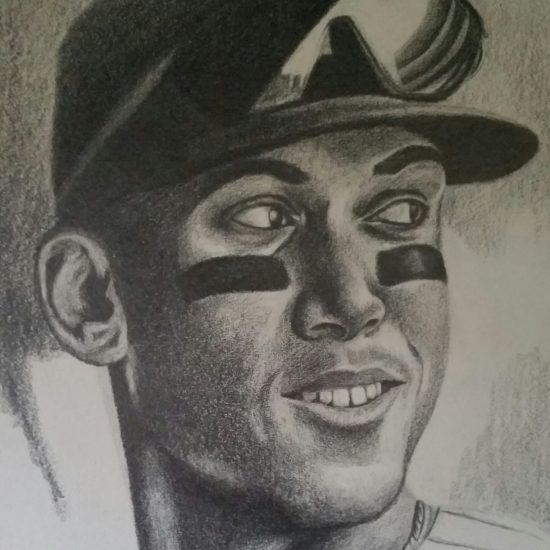Last year saw quite a few disappointments including Juan Soto and Giancarlo Stanton whose batting averages hit career lows. Lucas Giolito was another dud who posted a 4.90 ERA and 1.44 WHIP. I won’t detail Giolito, but be sure to check out John Foley’s article here. An impending unrestricted free agent, he could be a very interesting player to watch this upcoming season. Let’s take a closer look at four other busts from last year.
After signing a five-year deal with the Phillies, Nick Castellanos ended up being one of 2022’s biggest disappointments posting a career-low .694 OPS with 14 home runs, the fewest he’s hit since his rookie season. As variance would have it, he reached a career-best .939 OPS in 2021, his second in Cincinnati.
His expected stats were down across the board, so at first glance, this doesn’t look like a case of simply underperforming. His AEV on FB/LD plummeted and led to his lowest HR/FB% since 2015. He came into last season with a career HR/FB% rate of 14.1%. But last year his AEV on FB/LD plummeted and led to his lowest HR/FB% rate since the 7.4% he posted during his rookie 2014 season.
Castellanos has been an excellent run producer throughout most of his career, but the one thing he hasn’t excelled at is plate discipline. Before last season, he held a career BB rate of 6.6% and a .329 OBP. Every bit a free-swinger, the former Tiger posted a 40.1% O-Swing% from 2019-21, the eleventh highest mark among qualified hitters via FanGraphs. Last year, that number spiked to 43.6%. There was only one other qualified batter last year who swung at pitches out of the zone more frequently, Javier Báez.
Given the rise in his swing rate, it’s not a surprise that he saw more breaking pitches last year. Sliders in particular. In 2021, 23.3% of the pitches he saw were sliders. Last year, that climbed to 31.7%. His results, as you’d expect, weren’t great culminating in a -6 run value and .301 wOBA, the lowest he’s posted since 2019 with the Cubs (-8 and .277).
He seemed to have a hard time covering the low, outside corner. But that’s not really a new weakness as pitchers have attacked him there for years. The problem was that he swung at the low, outside corner more often as you’ll see below (catchers POV).
Castellanos Swing Rates 2021 Castellanos Swing Rates 2022
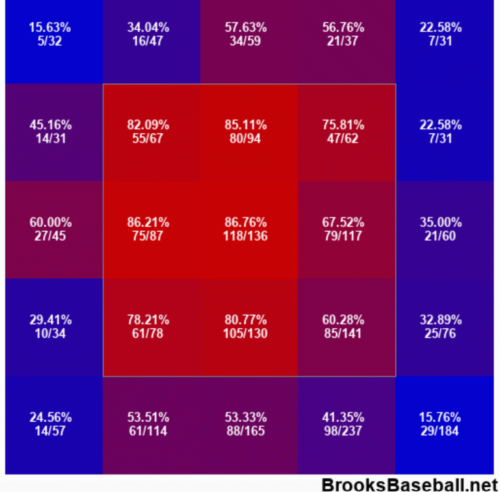
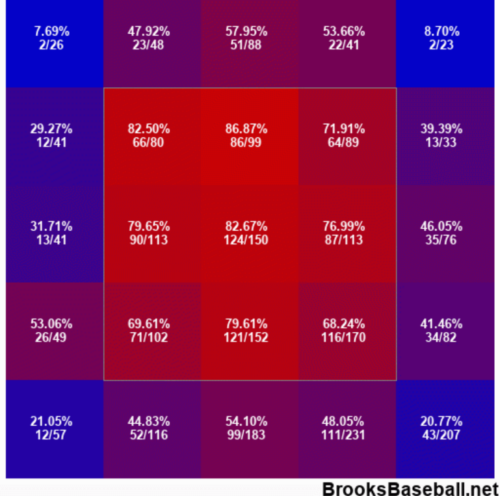
The other problem was he did less damage to hittable pitches. His xwOBA on pitches over the heart of the plate, or attack zones one through nine on Statcast, fell from .469 from 2019-21 to .382 last year.
2022 Rolling xwOBA

To his credit, Castellanos actually got off to a promising start hitting .300 with a .874 OPS in April (91 PA). Mets righty reliever Adonis Medina plunked him on the right wrist on May 5th. The timing is a little curious because you’ll note his production more or less taper off after that. But it ended up being only a bruise and wasn’t something that adversely affected him according to Phillies’ skipper Rob Thompson.
He also had a good August during which he hit .300 with a .833 OPS (105 PA). The last spike in the chart above correlates with August, suggesting that he might’ve been on the verge of turning things around. Unfortunately, an oblique strain on September 3rd ended whatever momentum he had going.
He made a rushed return in late September out of necessity with the postseason looming. While addressing the media shortly after the World Series, the team’s President of Baseball Operations, Dave Dombrowski, said that the timing of the injury wasn’t ideal and that Castellanos basically didn’t have enough time to really get his swing back. His disappointing postseason culminated in a 3-for-24 showing during the Fall Classic against the Astros.
Back in July, Dombrowski said, “He’s always expanded the strike zone. He’s expanding it more now than I’ve ever seen him expand it. But he’s a guy that hits line drives all over the field usually. It’s not like he’s old by any means and all of a sudden he’s going to lose that ability.” Worth noting that he drafted Castellanos back in 2010 with the Tigers.
At the end of the year, Dombrowski also mentioned that improved plate discipline should be a point of emphasis for the upcoming season and that he doesn’t believe there is a reason why Castellanos can’t get back to being an offensive force.
Steamer forecasts 20 home runs which seems perfectly plausible if not conservative considering he’s cleared 20 in each of his previous five seasons, excluding 2020 (14 HR/242 PA). Working in his favor is Citizens Bank Park, which is ranked fifth best in Statcast’s HR factor for RHB over the past three years.
Verdict: Last year’s results were deserved. His batted ball metrics were down and it seems like pitchers took advantage of his aggressive approach which led to him being force-fed sliders on the outer half. But Castellanos is a proven hitter who I think is capable of adjusting while also getting better results against pitches over the heart of the plate. Hitting in one of baseball’s top lineups in a good hitter’s park, he makes a lot of sense as a potential rebound candidate, especially in batting-average leagues.
Drafted out of high school by Miami 13th overall in 2017, the 25-year-old southpaw was terrific in 2021 and gained a lot of steam as a popular pick in fantasy drafts for 2022. But the results this past season were not so great before a lat injury ended his year in mid-September. So, what happened?
One thing that jumped off the page were the results against his fastball. In short, it missed fewer bats and got beat up. In 2021, the heater accrued an excellent run value of -16. Last year’s run value of 11 was on the opposite end of the spectrum. After allowing five home runs in 2021, his heater coughed up 11 across 26 fewer innings.
The shape of his fastball changed and picked up 1.5 inches of horizontal break to 12.6, which was five inches or 66% above the league average. In essence, it acted a bit more like a cutter relative to 2021. Rogers decreased the horizontal movement on his fastball from 2020 to 2021, so I’m interested to see if he reverts back to that next year since it might’ve made a difference. It’s a guess, but the results make me think that his fastball command could have suffered with the added cut, ie too many drifted over the middle of the plate. The good news was that his velocity was about the same at 94.6 MPH last year versus 94.5 MPH in 2021. The heater missed fewer bats last year, but as you can see below (catcher’s POV), it still earned whiffs up in the zone.
2021 Fastball Whiff Rates 2022 Fastball Whiff Rates
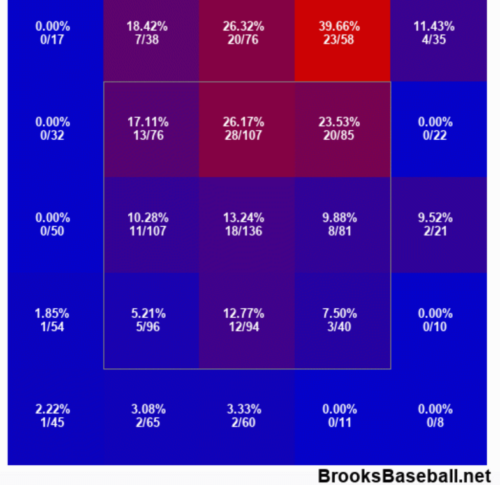
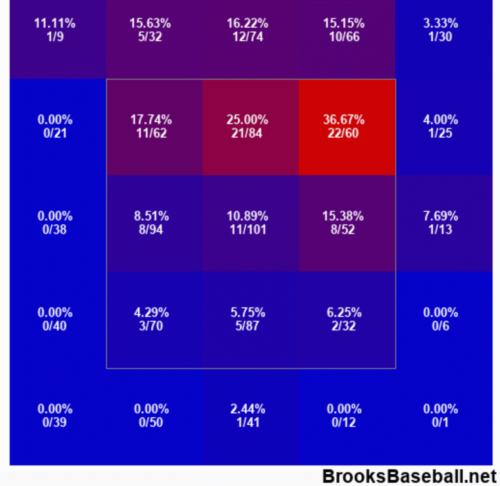
Rogers’ terrific changeup took a step back last year. It lost an inch of drop, although according to Statcast, it was still 13% above average in that respect. The substantial drop in SwStr% was fueled, at least in part, by a drop in chase rate (O-Sw%) from 48.3% to 38.5%. You can see his changeup’s whiff rates below (catcher’s POV).
He also threw his changeup harder last year at 85.7 MPH compared to 84.8 MPH in 2021. It doesn’t seem like much, but given that his fastball velocity stayed about the same, maybe the shrinking differential played a part in the pitch earning fewer whiffs.
2021 Changeup Whiff Rates 2022 Changeup Whiff Rates
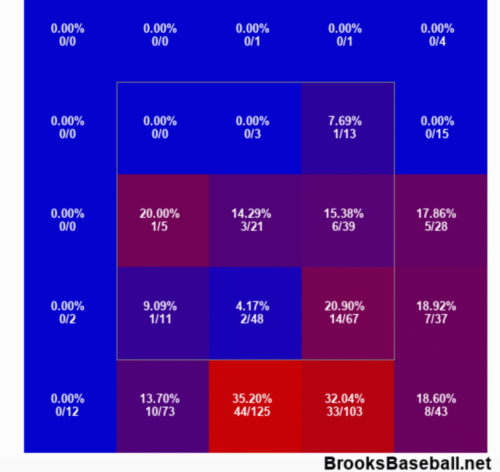
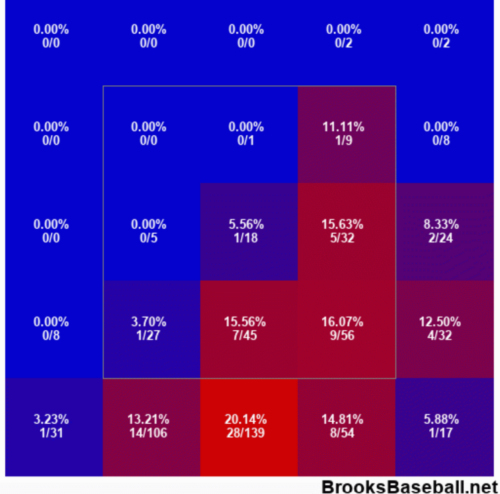
One interesting thing that Ben Clemens on FanGraphs pointed out is that Rogers started to throw his changeup more often to lefties last year accounting for the small bump in overall usage. Against opposite-handed hitters, he used it at just about the same clip as in 2021.
His slider picked up about six inches of horizontal movement, but it was still below average by 34% according to Statcast. It also led his arsenal with a 16.20% SwStr% as its chase rate (O-Sw%) rose from 23.6% to 33.8%, just above the league-average mark of 33.6%.
Verdict: It’s a hedge on my part, but I view Rogers as a work in progress rather than a bust. Did he deserve last year’s 5.47 ERA? Probably not. The 13.2% HR/FB rate seemed a little harsh. But at the same time, for whatever reason, his changeup and fastball just weren’t as effective last year in earning whiffs which caused his K rate to drop from 28.5% to 22.2%.
We did see his slider perform a bit better overall last year. But, to me, it’s still a distant third pitch. The way Rogers reaches his ceiling is all about getting his fastball and change working in tandem more consistently. We’ve seen his fastball earn whiffs up in the zone and his changeup get batters to chase. And we saw it at times last year. For example, on September 12th against the Rangers (6.1 IP, 9 K’s, 2 ER, 4 hits, 2 BBs) his change returned a 40% CSW. The path is still there. It’s just a case of doing it more frequently. For now, he carries strikeout upside but with start-to-start volatility given that he’s a young pitcher who is amidst refining his command.
The former Cubs shortstop had a dreadful Detroit debut. If you follow baseball even a little you’re not surprised to see Báez end the season with one of the lowest OBPs in baseball, his .278 was the fifth-worst among qualifiers last year. The lowest? That would be his teammate Jonathan Schoop at .239. Amazingly enough, the A’s ended up having the lowest team OBP at .281 trailing the Tigers at .286.
When we talked about Castellanos earlier, the number of sliders he saw last year stuck out. It’s a similar story with Báez. Last year, he saw even more sliders at 34.3%. Compare that to 2021, when he saw sliders at a 24.9% clip. Against sliders last year, he hit .195 and produced a run value of -14. I think it’s safe to say that pitchers won’t be abandoning that strategy anytime soon.
El Mago buoyed his final line by hitting .301 against southpaws. But against righties, he hit .217 with a .618 OPS. The poor results were almost certainly amplified by all the sliders he saw. And given that his splits against righties over the previous two seasons weren’t great, to begin with, this could cause his production to bottom out.
Verdict: Of the four players here, Báez is the one I’m most worried about. We know that Comerica isn’t going to help his power output as its HR factor for RHB ranked 26th (Three-year rolling average: 2020-22). That certainly could’ve played a part in last year’s 12.3% HR/FB rate which was a career-low if you ignore 2015 (80 PA). His splits last year against RHP were pretty alarming, especially considering the big bump in sliders he saw last year. To his credit, he surprisingly trimmed his K rate to 24.9%. But if you believe in a correction closer to his career mark of 28.6%, and Steamer does, then his average might continue to spiral downward. Yes, he could hit 25 HR and swipe ten bags, but the juice in the other categories might not be worth the squeeze considering that Detroit, despite having some young talent that might peak in the not-too-distant future, produced the fewest runs in baseball last season.
The Mariners acquired Winker from the Reds in mid-March. After posting a .888 OPS through his first five seasons in Cincinnati, the first-time All-Star was a massive disappointment in Seattle with a career-low .688 OPS. Despite the downturn, his K/BB was as strong as ever backed by a chase rate of 18.8% (28.4% was the league average).
The Park Factors above (via baseballsavant.com) are normalized to 100. After enjoying the hitter’s haven that is the GABP, Winker’s new home in Seattle was the opposite and ranked 30th in overall park factor for lefties. Following an offseason trade to the Brewers, he finds himself back in another favorable park for lefty power, lending some credence to a possible bounce back.
Of course, park factors can’t explain away last year’s poor season, but it helps to add a little context. It’s random Statcast trivia, but oddly enough, in 2021 he would’ve hit the exact same amount of home runs (24) if he had played all his games in T-Mobile Park. Last year, he would’ve hit 17 at T-Mobile Park, 23 at GABP, and 18 at American Family Field if he had played all his games at those venues.
Previously a hitter whose profile leaned in favor of groundballs, Winker parlayed a career-high 25.3% flyball rate into a personal best 24 home runs in 2021. But last year’s batted ball metrics were down across the board. The lefty’s HR/FB% cratered to under 10% for the second time in his career (8.9% in 2018) in part due to the massive drop in AEV on FB/LD.
But as a 29-year-old in the middle of his prime, the abrupt downturn seems surprising. And there seems to be a fairly reasonable explanation; He was playing hurt. In October, Winker had a procedure done on his left knee and he later had surgery for a bulging disc in his neck. Speaking at the end of the season, Mariners GM Jerry DiPoto seemed adamant in his belief that Winker’s struggles were the result of playing at less than full strength.
Verdict: Last year’s batted ball data warranted the lackluster results. But the downturn seems to have been precipitated by injuries that required surgery. Assuming health, he’s a bounceback candidate. Last year’s 547 plate appearances were actually a career-high, his previous high being 485 in 2021. A lot of that has to do with previous injuries. But it’s also because he owns a career .205/ .321/ .339 slash against LHP (446 PA) which limits his appeal in weekly leagues. However, he’s a tremendous play in daily leagues, where you can take advantage of his .288/ .388/ .496 career slash against RHP (1624 PA).
Adapted by Chris Corr(@Chris_Studios on Twitter)

